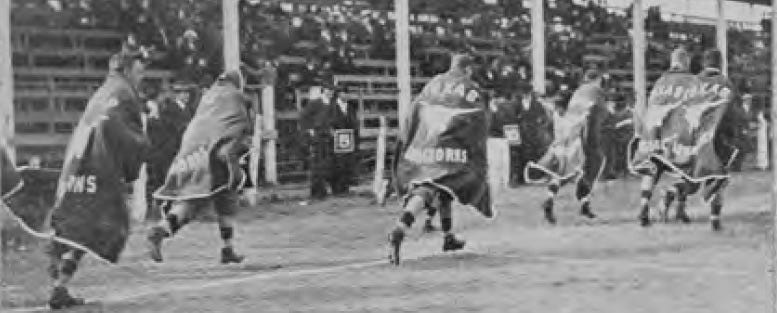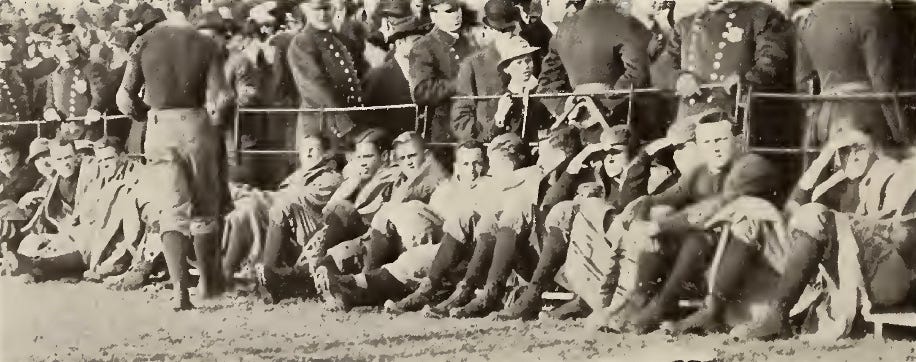Football Blankets and Feeling Warm All Over
Offensive formations evolved over the years, and some, like the Single Wing, largely disappeared. Likewise, other aspects of the game that were once commonplace have been gone so long few realize they were ever part of the game. Such is the case with football blankets, a common sight on football fields when the leaves began changing colors one hundred some years ago.
Football blankets of old served functional and symbolic purposes. Players first brought blankets onto the field to -wait for it- keep warm while sitting on the bench. In the single platoon football of the day, second-string players often sat on the bench the entire game. Teams commonly played only eleven, twelve, or thirteen players in games against evenly matched opponents. By rule, substitutes had to be seated on the sideline and got chilly when the gales of November came early. It only took a few intelligent reserves bringing blankets to the sidelines before the wraps were off, and soon, everybody was doing it.

Given the absence of sideline heaters and team-issued jackets, the fact that substitutes brought blankets onto the field should be no surprise. It was more surprising that starters jogged onto the field wrapped in blankets, and they did so for two reasons. First, the starters sometimes left the game, and blankets helped them keep warm while nursing an injury or waiting to reenter the game. Second and more important, early stadiums did not have locker rooms. Unable to spend halftime in a heated room, teams went to one end of the field to rest and talk things over, all while the starters wrapped themselves in their blankets. There were exceptions, of course. The Carlisle teams of the 1890s, who were pretty tough lads, laughed at their white opponents for blanketing themselves against adverse weather.

Presumably, the first blankets brought onto the field came in assorted fabrics and colors, but the desire for brand consistency soon led to blankets bearing team colors and logos. And since the small stadiums of the day meant there were limited ticket revenues, student bodies commonly held dances or passed the donation hat to pay for the team's blankets. The fundraising honor at some schools went to the campus coeds, law students, or another group willing to distinguish themselves. But, regardless of who did the fundraising, few fan bases were ready to watch their boys shiver when the fellows across the field were wrapped snugly in their team colors. That did not feel or look right.

That takes us to the symbolic nature of football blankets. Football teams of the 1800s often wore wool jerseys with a letter or similar school symbol on the chest. Tops teams of the era loaded their early schedules with lesser teams, saving their best players for the big games at the end of the season. Those playing in rivalry games were each team's top players, and to recognize them, Harvard allowed its starters to keep their jerseys at season's end. Thus began the tradition of awarding varsity letter sweaters and related items.
Somewhere around the turn of the century, the tradition evolved from players keeping their game-used sweaters to being awarded separate sweaters, perhaps better suited for wear in social settings than the gridiron. During the same period, but specifically in 1904, Amos Alonzo Stagg created the "Order of the C" letter winners' club at Chicago, the first formal awarding of letters by a school. Chicago's other innovation was to award blankets to its seniors. Blankets then and now acknowledged long-term commitment and excellence. Anyone can earn a letter for a single season, but blankets are reserved for those lettering in the same sport for three or four years.

While the idea of awarding blankets to those showing commitment is inherently cool, a few schools took it further to demonstrate even longer-term commitment to their programs. The tradition at the universities of Washington and Puget Sound, for example, was for former football players to bring their blankets back to campus on Homecoming. Like the lanes of cheerleaders and dance teams that players run through before games today, their football alums created similar paths while holding their blankets in front of them.

Using blankets along the sideline went away after WWII when teams transitioned to hooded and lined capes or other means of keeping players dry and warm. The advent of portable heaters and wicking fabrics further reduced the impact of the cold and rain, as do modern substitution patterns, to say nothing of playing in domed stadiums. While we see few blankets on the field nowadays, awarding blankets to seniors continues in spots across the country. Ol' Chicago still gives blankets to its senior athletes. So does BYU, Augustana (IL), Hope (MI), and surely others carry on the tradition.
Now, doesn't that make you feel warm and cozy all over?

Football Archaeology is reader-supported. Click here to buy one of my books or otherwise support the site.


